Guide to Understanding Sail Rig Types (with Pictures)
There are a lot of different sail rig types and it can be difficult to remember what's what. So I've come up with a system. Let me explain it in this article.
What are the different types of sail rig? The sail rig is determined by the number of masts and the layout and shape of sails. Most modern ships are fore-and-aft rigged, while old ships are square-rigged. Rigs with one mast are sloops and cutters. Ketches, yawls, brigs, and schooners have two masts. Barques have three masts. Rigs can contain up to seven masts.
'Yeah, that's a gaff brig, and that a Bermuda cutter' - If you don't know what this means (neither did I) and want to know what to call a two-masted ship with a square-rigged mainsail, this article is definitely for you.
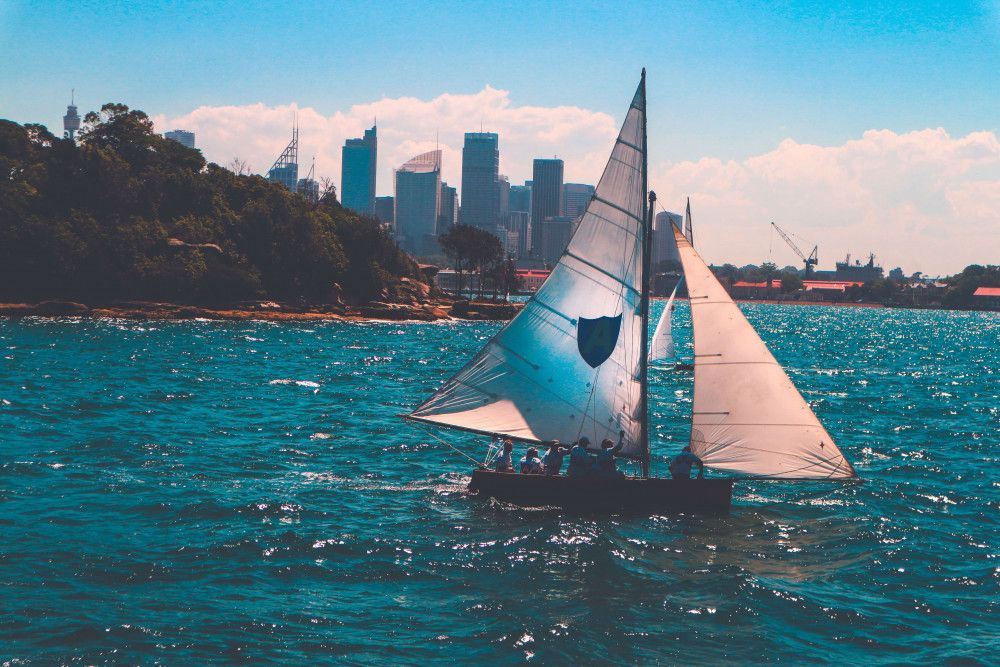
On this page:
This article is part 2 of my series on sails and rig types. Part 1 is all about the different types of sails. If you want to know everything there is to know about sails once and for all, I really recommend you read it. It gives a good overview of sail types and is easy to understand.
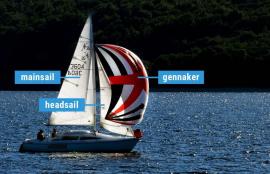
The Ultimate Guide to Sail Types and Rigs (with Pictures)
More Info on Sail Rig Types
First of all, what is a sail rig? A sail rig is the way in which the sails are attached to the mast(s). In other words, it's the setup or configuration of the sailboat. The rig consists of the sail and mast hardware. The sail rig and sail type are both part of the sail plan. We usually use the sail rig type to refer to the type of boat.
Let's start by taking a look at the most commonly used modern sail rigs. Don't worry if you don't exactly understand what's going on. At the end of this article, you'll understand everything about rig types.
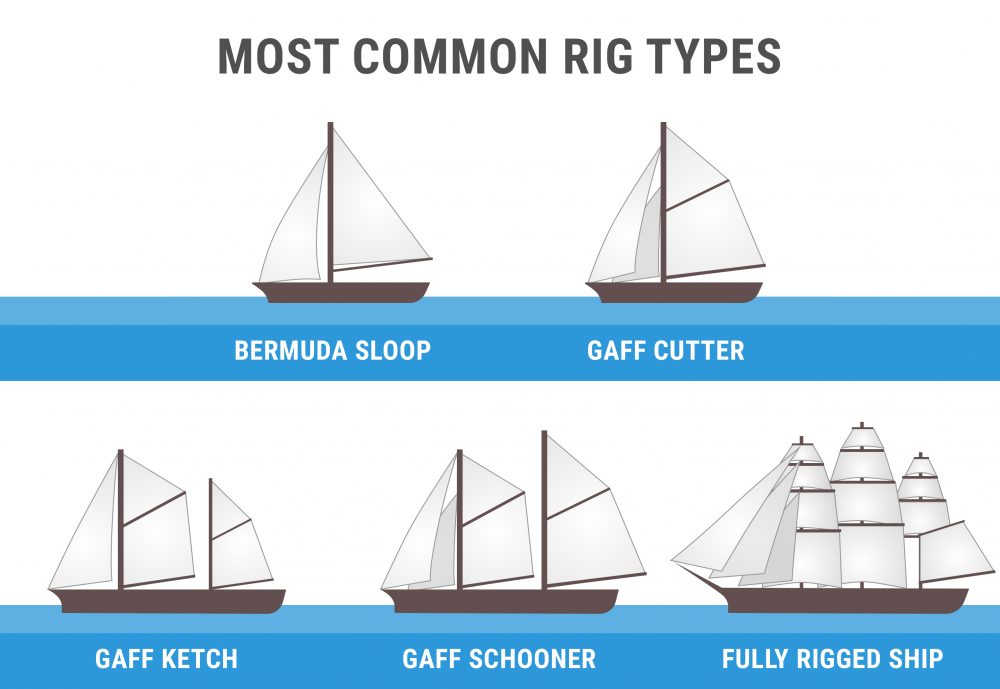
The sail rig and sail plan are often used interchangeably. When we talk of the sail rig we usually mean the sail plan. Although they are not quite the same. A sail plan is the set of drawings by the naval architect that shows the different combinations of sails and how they are set up for different weather conditions. For example a light air sail plan, storm sail plan, and the working sail plan (which is used most of the time).
So let's take a look at the three things that make up the sail plan.
The 3 things that make up the sail plan
I want to do a quick recap of my previous article. A sail plan is made up of:
- Mast configuration - refers to the number of masts and where they are placed
- Sail type - refers to the sail shape and functionality
- Rig type - refers to the way these sails are set up on your boat
I'll explore the most common rig types in detail later in this post. I've also added pictures to learn to recognize them more easily. (Click here to skip to the section with pictures).
How to recognize the sail plan?
So how do you know what kind of boat you're dealing with? If you want to determine what the rig type of a boat is, you need to look at these three things:
- Check the number of masts, and how they are set up.
- You look at the type of sails used (the shape of the sails, how many there are, and what functionality they have).
- And you have to determine the rig type, which means the way the sails are set up.
Below I'll explain each of these factors in more detail.
The most common rig types on sailboats
To give you an idea of the most-used sail rigs, I'll quickly summarize some sail plans below and mention the three things that make up their sail plan.
- Bermuda sloop - one mast, one mainsail, one headsail, fore-and-aft rigged
- Gaff cutter - one mast, one mainsail, two staysails, fore-and-aft rigged
- Gaff schooner - two-masted (foremast), two mainsails, staysails, fore-and-aft rigged
- Gaff ketch - two-masted (mizzen), two mainsails, staysails, fore-and-aft rigged
- Full-rigged ship or tall ship - three or more masts, mainsail on each mast, staysails, square-rigged
The first word is the shape and rigging of the mainsail. So this is the way the sail is attached to the mast. I'll go into this later on. The second word refers to the mast setup and amount of sails used.
Most sailboats are Bermuda sloops. Gaff-rigged sails are mostly found on older, classic boats. Square-rigged sails are generally not used anymore.
But first I want to discuss the three factors that make up the sail plan in more detail.
Mast Configurations and Rig Types
Ways to rig sails
There are basically two ways to rig sails:
- From side to side, called Square-rigged sails - the classic pirate sails
- From front to back, called Fore-and-aft rigged sails - the modern sail rig
Almost all boats are fore-and-aft rigged nowadays.
Square sails are good for running downwind, but they're pretty useless when you're on an upwind tack. These sails were used on Viking longships, for example. Their boats were quicker downwind than the boats with fore-and-aft rigged sails, but they didn't handle as well.
The Arabs first used fore-and-aft rigged sails, making them quicker in difficult wind conditions.
Quick recap from part 1: the reason most boats are fore-and-aft rigged today is the increased maneuverability of this configuration. A square-rigged ship is only good for downwind runs, but a fore-and-aft rigged ship can sail close to the wind, using the lift to move forward.
The way the sails are attached to the mast determines the shape of the sail. The square-rigged sails are always attached the same way to the mast. The fore-and-aft rig, however, has a lot of variations.
The three main sail rigs are:
- Bermuda rig - most used - has a three-sided (triangular) mainsail
- Gaff rig - has a four-sided mainsail, the head of the mainsail is guided by a gaff
- Lateen rig - has a three-sided (triangular) mainsail on a long yard
The Bermuda is the most used, the gaff is a bit old-fashioned, and the lateen rig is outdated (about a thousand years). Lateen rigs were used by the Moors. The Bermuda rig is actually based on the Lateen rig (the Dutch got inspired by the Moors).

Other rig types that are not very common anymore are:
- Junk rig - has horizontal battens to control the sail
- Gunter rig
- Settee rig - Lateen with the front corner cut off
- Crabclaw rig
Mast configuration
Okay, we know the shape of the mainsail. Now it's time to take a look at the mast configuration. The first thing is the number of masts:
- one-masted boats
- two-masted boats
- three-masted boats
- four masts or up
- full or ship-rigged boats - also called 'ships' or 'tall ships'
I've briefly mentioned the one and two mast configurations in part 1 of this article. In this part, I'll also go over the three-masted configurations, and the tall ships as well.
A boat with one mast has a straightforward configuration because there's just one mast. You can choose to carry more sails or less, but that's about it.
A boat with two masts or more gets interesting. When you add a mast, it means you have to decide where to put the extra mast: in front, or in back of the mainmast. You can also choose whether or not the extra mast will carry an extra mainsail. The placement and size of the extra mast are important in determining what kind of boat we're dealing with. So you start by locating the largest mast, which is always the mainmast.
From front to back: the first mast is called the foremast. The middle mast is called the mainmast. And the rear mast is called the mizzenmast.

What is the mizzenmast? The mizzenmast is the aft-most (rear) mast on a sailboat with three or more masts or the mast behind the mainmast on a boat with two masts. The mizzenmast carries the mizzen sail. On a two-masted boat, the mizzenmast is always (slightly) smaller than the mainmast.
What is the purpose of the mizzen sail? The mizzen sail provides more sail area and flexibility in sail plan. It can be used as a big wind rudder, helping the sailor to have more control over the stern of the ship. It pushes the stern away from the wind and forces the bow in the opposite way. This may help to bring the bow into the wind when at anchor.
I always look at the number of masts first, because this is the easiest to spot. So to make this stuff more easy to understand, I've divided up the rig types based on the number of masts below.
Why would you want more masts and sail anyways?
Good question. The biggest advantage of two masts compared to one (let's say a ketch compared to a sloop), is that it allows you to use multiple smaller sails to get the same sail area. It also allows for shorter masts.
This means you reduce the stress on the rigging and the masts, which makes the ketch rig safer and less prone to wear and tear. It also doesn't capsize as quickly. So there are a couple of real advantages of a ketch rig over a sloop rig.
Rigs with One Mast
In the case of one mast, we look at the number of sails it carries.
Boats with one mast can have either one sail, two sails, or three or more sails.
Most single-masted boats are sloops, which means one mast with two sails (mainsail + headsail). The extra sail increases maneuverability. The mainsail gives you control over the stern, while the headsail gives you control over the bow.
Sailor tip: you steer a boat using its sails, not using its rudder.
The one-masted rigs are:
- Cat - one mast, one sail
- Sloop - one mast, two sails
- Cutter - one mast, three or more sails
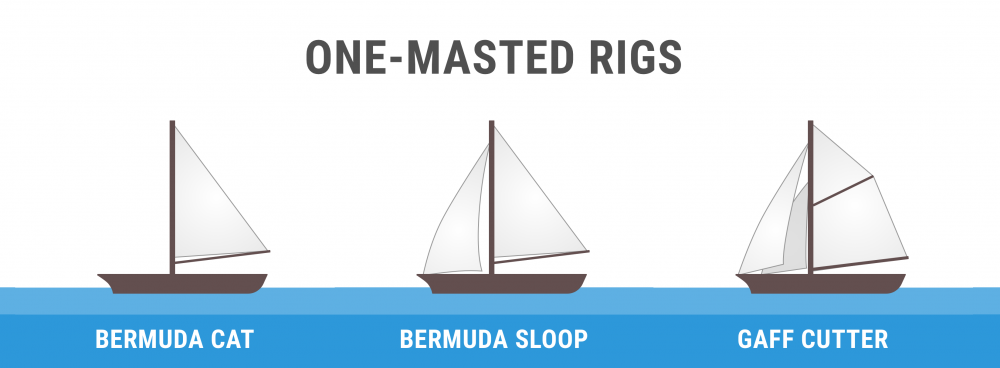
Cat
The cat is the simplest sail plan and has one mast with one sail. It's easy to handle alone, so it's very popular as a fishing boat. Most (very) small sailboats are catboats, like the Sunfish, and many Laser varieties. But it has a limited sail area and doesn't give you the control and options you have with more sails.
Sloop
The most common sail plan is the sloop. It has one mast and two sails: the main and headsail. Most sloops have a Bermuda mainsail. It's one of the best racing rigs because it's able to sail very close to the wind (also called 'weatherly'). It's one of the fastest rig types for upwind sailing.
It's a simple sail plan that allows for high performance, and you can sail it short-handed. That's why most sailboats you see today are (Bermuda) sloops.
This rig is also called the Marconi rig, and it was developed by a Dutch Bermudian (or a Bermudian Dutchman) - someone from Holland who lived on Bermuda.
Cutter
A cutter has three or more sails. Usually, the sail plan looks a lot like the sloop, but it has three headsails instead of one. Naval cutters can carry up to 6 sails.
Cutters have larger sail area, so they are better in light air. The partition of the sail area into more smaller sails give you more control in heavier winds as well. Cutters are considered better for bluewater sailing than sloops (although sloops will do fine also). But the additional sails just give you a bit more to play with.
Rigs with Two Masts
Two-masted boats can have an extra mast in front or behind the mainmast. If the extra mast is behind (aft of) the mainmast, it's called a mizzenmast. If it's in front of the mainmast, it's called a foremast.
If you look at a boat with two masts and it has a foremast, it's most likely either a schooner or a brig. It's easy to recognize a foremast: the foremast is smaller than the aft mast.
If the aft mast is smaller than the front mast, it is a sail plan with a mizzenmast. That means the extra mast has been placed at the back of the boat. In this case, the front mast isn't the foremast, but the mainmast. Boats with two masts that have a mizzenmast are most likely a yawl or ketch.
The two-masted rigs are:
- Lugger - two masts (mizzen), with lugsail (a cross between gaff rig and lateen rig) on both masts
- Yawl - two masts (mizzen), fore-and-aft rigged on both masts. Main mast is much taller than mizzen. Mizzen without a mainsail.
- Ketch - two masts (mizzen), fore-and-aft rigged on both masts. Main mast with only slightly smaller mizzen. Mizzen has mainsail.
- Schooner - two masts (foremast), generally gaff rig on both masts. Main mast with only slightly smaller foremast. Sometimes build with three masts, up to seven in the age of sail.
- Bilander - two masts (foremast). Has a lateen-rigged mainsail and square-rigged sails on the foremast and topsails.
- Brig - two masts (foremast), partially square-rigged. The main mast carries small lateen-rigged sail.

Yawl
The yawl has two masts that are fore-and-aft rigged and a mizzenmast. The mizzenmast is much shorter than the mainmast, and it doesn't carry a mainsail. The mizzenmast is located aft of the rudder and is mainly used to increase helm balance.
Ketch
A ketch has two masts that are fore-and-aft rigged. The extra mast is a mizzenmast. It's nearly as tall as the mainmast and carries a mainsail. Usually, the mainsails of the ketch are gaff-rigged, but there are Bermuda-rigged ketches too. The mizzenmast is located in front of the rudder instead of aft, as on the yawl.
The function of the ketch's mizzen sail is different from that of the yawl. It's actually used to drive the boat forward, and the mizzen sail, together with the headsail, are sufficient to sail the ketch. The mizzen sail on a yawl can't really drive the boat forward.
Schooner
Schooners have two masts that are fore-and-aft rigged. The extra mast is a foremast which is generally smaller than the mainmast, but it does carry a mainsail. Schooners are also built with a lot more masts, up to seven (not anymore). The schooner's mainsails are generally gaff-rigged.
The schooner is easy to sail but not very fast. It handles easier than a sloop, except for upwind, and it's only because of better technology that sloops are now more popular than the schooner.
Brig
The brig has two masts. The foremast is always square-rigged. The mainmast can be square-rigged or is partially square-rigged. Some brigs carry a lateen mainsail on the mainmast, with square-rigged topsails.
Some variations on the brig are:
Brigantine - two masts (foremast), partially square-rigged. Mainmast carries no square-rigged mainsail.
Hermaphrodite brig - also called half brig or schooner brig. Has two masts (foremast), partially square-rigged. Mainmast carries a gaff rig mainsail and topsail, making it half schooner.
Rigs with Three Masts
Three-masted boats are mostly barques or schooners. Sometimes sail plans with two masts are used with more masts.
The three-masted rigs are:
- Barque - three masts, fore, and mainmast are square-rigged, the mizzenmast is usually gaff-rigged. All masts carry mainsail.
- Barquentine - three masts, foremast is square-rigged, the main and mizzenmast are fore-and-aft rigged. Also called the schooner barque.
- Polacca - three masts, foremast is square-rigged, the main and mizzenmast are lateen-rigged.
- Xebec - three masts, all masts are lateen-rigged.

Barques
A barque has three or four masts. The fore and mainmast are square-rigged, and the mizzen fore-and-aft, usually gaff-rigged. Carries a mainsail on each mast, but the mainsail shape differs per mast (square or gaff). Barques were built with up to five masts. Four-masted barques were quite common.
Barques were a good alternative to full-rigged ships because they require a lot fewer sailors. But they were also slower. Very popular rig for ocean crossings, so a great rig for merchants who travel long distances and don't want 30 - 50 sailors to run their ship.
Barquentine
The barquentine usually has three masts. The foremast is square-rigged and the main and mizzenmast fore-and-aft. The rear masts are usually gaff-rigged.
Faster than a barque or a schooner, but the performance is worse than both.
Polacca
The polacca or polacre rig has three masts with a square-rigged foremast. The main and mizzenmast are lateen-rigged. Beautiful boat to see. Polacca literally means 'Polish' (it's Italian). It was a popular rig type in the Mediterranean in the 17th century. It looks like the xebec, which has three lateen-rigged masts.
Fun fact: polaccas were used by a Dutch sailor-turned-Turkish-pirate (called Murat Reis).
Xebec
The xebec is a Mediterranean trading ship with three masts. All masts are lateen-rigged. I couldn't find any surviving xebecs, only models and paintings. So I guess this rig is outdated a long time.
Tall Ship
A boat with three or more masts that all carry square-rigged sails is called a ship, a tall ship, or a full-rigged ship. So it's at this point that we start calling boats 'ships'. It has nothing to do with size but with the type of rigging.
More sails mean less stress on all of them. These ships use a lot of sails to distribute the forces, which reduces the stress on the rigging and the masts. Square sails mean double the sail area in comparison to triangular sails.
They are quite fast for their size, and they could outrun most sloops and schooners (schooners were relatively a lot heavier). The reason is that tall ships could be a lot longer than sloops, giving them a lot of extra hull speed. Sloops couldn't be as large because there weren't strong enough materials available. Try making a single triangular sail with a sail area of over 500 sq. ft. from linen.
So a lot of smaller sails made sense. You could have a large ship with a good maximum hull speed, without your sails ripping apart with every gust of wind.
But you need A LOT of sailors to sail a tall ship: about 30 sailors in total to ie. reef down sails and operate the ship. That's really a lot.
Tall ships are used nowadays for racing, with the popular tall ship races traveling the world. Every four years I go and check them out when they are at Harlingen (which is very close to where I live).
Check out the amazing ships in this video of the tall ship races last year near my hometown. (The event was organized by friends of mine).
Related Questions
What is the difference between a schooner and a sloop? A schooner has two masts, whereas the sloop only has one. The schooner carries more sails, with a mainsail on both masts. Also, sloops are usually Bermuda-rigged, whereas schooners are usually gaff-rigged. Most schooners also carry one or two additional headsails, in contrast to the single jib of the sloop.
What do you call a two-masted sailboat? A two-masted sailboat is most likely a yawl, ketch, schooner, or brig. To determine which one it is you have to locate the mainmast (the tallest). At the rear: schooner or brig. In front: yawl or ketch. Brigs have a square-rigged foremast, schooners don't. Ketches carry a mainsail on the rear mast; yawls don't.
What is a sloop rig? A sloop rig is a sailboat with one mast and two sails: a mainsail and headsail. It's a simple sail plan that handles well and offers good upwind performance. The sloop rig can be sailed shorthanded and is able to sail very close to the wind, making it very popular. Most recreational sailboats use a sloop rig.
What is the difference between a ketch and a yawl? The most important difference between a ketch and a yawl are the position and height of the mizzenmast. The mizzenmast on a yawl is located aft of the rudder, is shorter than the mainmast and doesn't carry a mainsail. On a ketch, it's nearly as long as the mainmast and carries a mainsail.
Did you find the answer to your specific question?
👍 80 👎 35



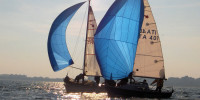
Comments
Faustino
There are a wonderful lots of DIY changeability shows on the cable airwaves these days.
Rick the rigger
There are SO many errors on this site it really should be taken down.
First major mistake is to say you are no longer afraid of the sea.
One that truly gets up my nose is the term ‘fully’ rigged ship. It’s a FULL rigged ship!!
Your mast names are the wrong way round and just because there may be 3 it doesn’t automatically mean the one in the middle is the main.
I could go on and totally destroy your over inflated but fragile ego but I won’t. All I will say is go learn a lot more before posting.
Shawn Buckles
Hi Rick,
Thanks for your feedback. If you like to point out anything more specific, please let me know and I will update the articles.
I’ve changed fully-rigged to full-rigged ship - which is a typo on my part.
I try to be as concise as I can, but, obviously, we all make mistakes every now and then. The great thing about the internet is that we can learn from each other and update our knowledge together.
If you want to write yourself and share your knowledge, please consider applying as a writer for my blog by clicking on the top banner.
Thanks, Shawn
Rosso
Well, I feel that I’ve learned a bit from this. The information is clear and well laid out. Is it accurate? I can’t see anything at odds with the little I knew before, except that I understood a xebec has a square rigged centre mainmast, such as the Pelican (https://www.adventureundersail.com/)
Anthony
Hi, Shawn, You forgot (failed) to mention another type of rig? The oldest type of rig known and still functions today JUNK RIG!
Phil
Why are so many of the comments here negative. I think it is wonderful to share knowledge and learn together. I knew a little about the subject (I’m an Aubrey-Maturin fan!) but still found this clarified some things for me. I can’t comment therefore on the accuracy of the article, but it seems clear to me that the spirit of the author is positive. We owe you some more bonhomme I suggest Shawn.
As they say in the Navy: “BZ” - for a good article.
Steven
Been reading S.M. Stirling and wanted to understand the ship types he references. Thank you, very helpful.
David
This site is an awesome starting point for anyone who would like to get an overview of the subject. I am gratefull to Shawn for sharing - Thanks & Kudos to you! If the negative reviewers want to get a deeper technical knowledge that is accurate to the n-th then go study the appropriate material. Contribute rather than destroy another’s good work. Well done Shawn. Great job!
James
Good stuff Shawn - very helpful. As a novice, it’s too confusing to figure out in bits and pieces. Thanks for laying it out.
Sam
Hi Shawn,
First of all I have to say that Rick ‘the rigger’ is obviously the one with the “over inflated but fragile ego” and I laughed when you suggested he share his knowledge on your blog, well played!
As for the content it’s great, hope to read more soon!
Thanks Sam
Alec Lowenthal
Shawn,
I have a painting of a Spanish vessel, two masted, with. Lateen sails on both masts and a jib. The mainsail is ahead of the main mast (fore) and the other is aft of the mizzen mast. Would this be what you call lugger rig? I have not seen a similar picture.
Thanks,
Alec.
PJ
Thank you for your article I found easy to read and understand, and more importantly remember, which emphasises the well written.. Pity about the negative comments, but love your proactive responses!
Alec Lowenthal
This vessel, “SEBASTIAN” out of Garrucha, Almería, España, was painted by Gustave Gillman in 1899.
Sorry, picture not accepted!
Richard
Thank you for a very informative article. I sail a bit and am always looking for more knowledge. I like the way you put forth your info and I feel if you can’t say anything positive, then that person should have their own blog or keep their opinions to their-self. I will be looking for more from you. I salute your way of dealing with negative comments.
Cheers
Tanya
Thank you for a great intro to sailing boats! I searched different sailboats because I use old sails tp make bags and wanted to learn the difference. Way more than I ever expected. Thanks for all the work put in to teach the rest of us.
Ed Bailen
Your description of a cutter is lacking, and your illustrations of “cutters” are actually cutter-rigged sloops. On a true cutter, the mast is moved further aft (with more than 40% of the ship forward of the mast). A sloop uses tension in the backstay to tension the luff of the foresail. The cutter can’t do this.
Also, a bermuda-rigged ketch will have a line running from the top of the mainmast to the top of the mizzenmast.
Ben
wow great guide to rig types! thanks
Nick
Interesting guide, however I am confused about the description of the brig. You say the main mast on a brig can have a lateen sail, but in your picture it looks like a gaff sail to me. How is it a lateen sail?
Bobby
Hi Shawn, thank you for taking the time to share this information. It is clear and very helpful. I am new to sailing and thinking of buying my own blue water yacht. The information you have supplied is very useful. I still am seeking more information on performance and safety. Please keep up the good work. Best Regards
mickey fanelli
I’m starting to repair a model sailboat used in the lake I have three masts that have long been broken off and the sails need replacement. So my question is there a special relationship between the three masts I do have reminents of where the masts should go. they all broke off the boat along with the sails I can figure out where they go because of the old glue marks but it makes no sense. or does it really matter on a model thank you mickey
Jaribu
Cool, total novice here. I have learnt a lot. Thanks for sharing - the diagrams along with the text make it really easy to understand, especially for a beginner who hasn’t even stepped on a sailing boat.
Daryl Beatt
Thank you. Cleared up quite a few things for me. For example, I was familiar with the names “Xebecs” and “Polaccas” from recent reading about the Barbary War. I had gathered that the two Barbary types were better suited to sailing in the Med, but perhaps they were less able to be adaptable to military uses,(but one might assume that would be ok if one plans to board and fight, as opposed to fight a running gun duel). Specifically, the strangely one sided August 1, 1801 battle between the USS Enterprise under Lt. John Sterett and the Polacca cruiser Tripoli under Admiral Rais Mahomet Rous. On paper both ships seemed nearly equal in size, guns and crew, but pictures of the battle are confusing. While the Enterprise is usually rendered as the familiar schooner, the polacca Tripoli has been pictured in radically different ways. Thus the Wikipedia picture by Hoff in 1878 used to illustrate the Battle shows a Brig design for Tripoli, indicating 77 years later, polaccas were no longer common.
Lee Christiansen
I am curious as to what you would call a modern race boat with a fractional jib,not equipped for full masthead hoist? Thanks Lee
TLeeBlanq
Thanks Guy: The information and pictures really eliminate a lot of the mystery of the terminology and the meanings. Also appreciate the insight of the handling idiosyncrasies “hand” (staff) requirements to manage a vessel for one that has not been on the water much. I long to spend significant time afloat, but have concern about the ability to handle a vessel due to advancing age. The Significant Other prefers to sit (in AC comfort)and be entertained by parties of cruise line employees. Thanks again for the information.
Gordon Smith
Your discussion made no mention of the galleon, a vessel with either square-rigged Fore and Main masts and a shorter lateen-rigged Mizzen, or, on larger galleons, square-rigged Fore and Main masts, with a lateen-rigged Mizzen and a lateen-rigged Bonaventure mast, both shorter than either the Fore or Main masts. Also, it was not uncommon for a galleon to hoist a square-rigged bowsprit topsail in addition to the usual square-rigged spritsail.
Leave a comment